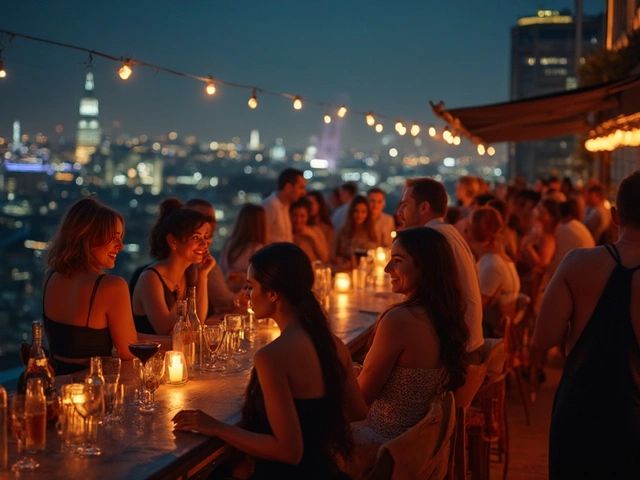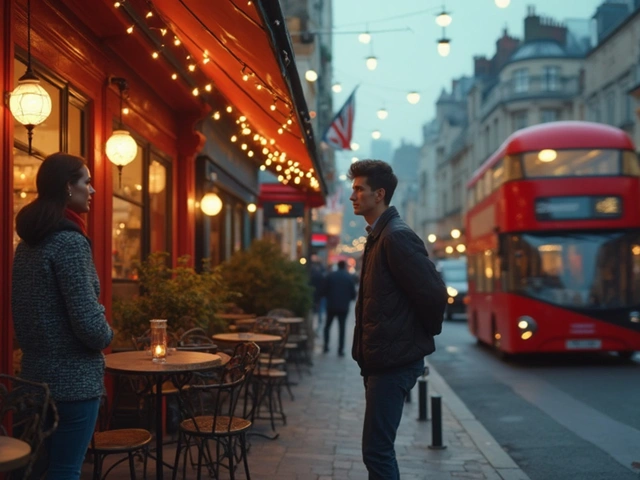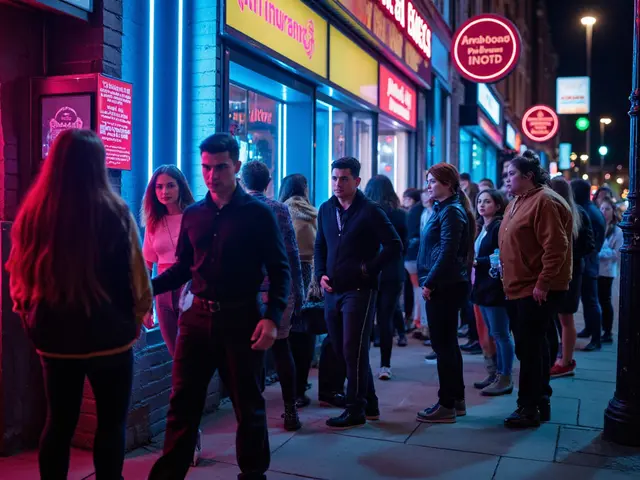If you think all night clubs are the same, London will prove you wrong—fast. The city’s club scene mixes every kind of crowd and sound you can imagine, and those differences matter more than you’d think. Planning a big night out? You’ll need to know more than just where to get tickets or how late things go. Most places are strict on entry, playlist changes are serious business, and locals have their own shortcuts to make nights run smoother.
Some of London’s biggest clubs are hidden in plain sight—often in old warehouses or even underground. Forget about just rocking up in trainers and expecting to get in anywhere. Want a tip? If a local tells you a club is “a little bit hard to find,” that’s code for: this place is worth your time. And if you want to dodge the worst crowds or save cash for the afterparty, there are tricks for that too. Let’s lay it all out, so you know exactly what you’re signing up for.
- The Real Vibe: Why London Clubs are Different
- Top Spots: Where Locals Actually Go
- Dress Codes and Door Policies: Avoid Rookie Mistakes
- How to Get In: Guest Lists, Queues, and Smart Moves
- Money Savers: Party on a Budget
- Late Night Eats and Getting Home
The Real Vibe: Why London Clubs are Different
London isn’t messing around when it comes to clubbing. The city’s history is packed with legendary venues—think Fabric, Ministry of Sound, and XOYO—places that helped shape dance music worldwide. But the scene keeps shifting. Walk down a side street in Dalston or Peckham, and you’ll find a club tucked behind a random shop or under a railway arch. London clubs aren’t just about flashing lights and big crowds; they’re about distinct sounds and crews who care about music. You’re just as likely to stumble into a tech house night as you are a jazz-funk session.
You’ll notice clubs here have a proud local feel. The crowd is a mash-up: students, diehards, city workers who cut loose after midnight, all spilled together depending on the night. Big international DJs love London for a reason, but it’s the resident acts and underground DJs who really set the tone. Many clubs take their sound seriously—XOYO even rotates resident DJs for months-long stints, and Fabric’s sound system gets nerdy love across the world.
Not every club is about dancing till sunrise, though. Some offer art installations or drag performances. Others, like Corsica Studios in Elephant & Castle, are known for experimental nights where anything goes musically. If you’re big on trends, London’s constantly testing something new—one week it’s afrobeat, the next it’s grime, then suddenly everyone’s talking about a pop-up disco in a car park.
Getting in can be tricky, but it’s not impossible. Most places have rules: big clubs like Fabric are super strict about ID checks, and some smaller spots won’t let you in if you’re too messy or look like you’re there for a fight. Bouncers actually do turn people away.
Here’s a quick look at what makes the top clubs different.
| Club | Type of Music | Known For | Neighbourhood |
|---|---|---|---|
| Fabric | Techno, House, Drum & Bass | Legendary sound system | Clerkenwell |
| XOYO | Electronic, Disco | Rotating resident DJs | Shoreditch |
| Ministry of Sound | EDM, House | World-famous lighting and crowd | Elephant & Castle |
| Corsica Studios | Experimental, Indie, House | Underground scene, art events | Elephant & Castle |
| Phonox | Techno, House, Urban | Intimate vibe, one DJ all night | Brixton |
There’s also practical stuff: age checks are serious, and most places scan your ID at the door, so don’t forget it. Bad news—most clubs don’t love big groups of blokes unless you’re on a list. Dress codes range from smart casual at Ministry to "express yourself, but not too weird" at Dalston basements.
The secret is, no matter your taste, there’s a night clubs London spot ready for you if you know where and how to look. Keep your ear to the ground, chat to local promoters on Instagram, and show clubs some respect—the vibe is a two-way street.
Top Spots: Where Locals Actually Go
London’s clubbing map has changed a lot—old legends shut down, new ones open in weird spots, and the best nights often aren’t the most advertised. Locals know it’s not just about the headlines; it’s about where the real party’s at.
Night clubs London: ask anyone who’s been here a while, and they’ll name Fabric first. This massive Farringdon club’s known for thumping bass, top DJs, and a crowd that actually comes for the music. Friday is more for techno and drum & bass lovers, Saturday leans house—check the lineup before you go.
Ministry of Sound isn’t just for tourists. It’s survived for nearly 35 years, still packs a world-class sound system, and gets the biggest names in the scene. But you’ll find more locals here if you hit up special events or legendary Sunday daytime sessions.
If you’re into something less in-your-face, go East. Dalston’s The Moth Club used to be a veterans’ club and now throws wild nights with indie bands, disco, and even drag shows. Cheap drinks, gold ceiling—locals love it for that offbeat vibe. Just down the road, Dalston Superstore is a queer-friendly haunt famous for its tiny but mental basement dancefloor and all-day parties, especially on weekends. The food ain’t bad either, in case you need a reset mid-rave.
Phonox in Brixton nails that sweet spot—big enough for a real party, small enough that you don’t get lost. It’s got a killer Martin Audio rig and one resident DJ who plays almost every weekend, so you get a properly curated night. If you want house and techno with a younger local crowd, this is your spot.
Low-key, South Londoners swear by Corsica Studios. Tucked under railway arches in Elephant & Castle, it’s all about underground sounds—techno, bass, breakbeats—and has two rooms with different vibes. The security is chill but firm, and the bar does proper pints without the usual club markup.
Last tip—always check the club’s Instagram or website before heading out. Londoners are obsessed with pop-ups and secret nights that often outdo the usual clubs. Don’t just follow the crowd; scan for special one-offs or “friends and family” nights—these are where the true local scene lives.
Dress Codes and Door Policies: Avoid Rookie Mistakes
Here’s the truth: when it comes to night clubs in London, getting inside is half the battle. It’s not just about looking good; it’s about matching the vibe the club wants. Dress codes aren’t a joke, especially at the top places around Soho, Mayfair, and Shoreditch. Rocking up with trainers (unless you’re at a warehouse rave where it’s part of the look) or sport jerseys? Expect the bouncer to turn you away without even blinking.
Most central London clubs want smart-casual as a minimum—think dark jeans, clean shoes, and a decent shirt for guys, and something sharp but not “trying too hard” for girls. Clubs like Cirque le Soir and Tape have a rep for turning away big groups of guys and those in streetwear, even if you’re on the guest list. Your best bet? Dress smarter than you think you need to. Don’t risk it just because you spotted someone inside with Air Max on their feet—they probably paid for a VIP table.
Door policies can be even trickier. If you’re in big groups, split up—especially if you’re a group of lads. Mixed groups (guys and girls together) usually breeze through lines much faster. Arrive early if you don’t want to deal with massive queues or entry drama—some clubs fill capacity by midnight and lock the doors. Oh, and bring your actual ID—no, a photo on your phone won’t work, and yes, they really do check everyone’s ID. Some clubs now use facial recognition for quicker entry, but don’t count on it everywhere yet.
| Club | Typical Dress Code | ID Check Type | Ratio Rules |
|---|---|---|---|
| Fabric | Casual/Trainers allowed | Physical ID | No strict group policy |
| Ministry of Sound | Smart-casual (no caps/tracksuits) | Physical ID | Mixed groups preferred |
| Tape London | Smart, no trainers | Physical ID & Scan | Balanced male/female ratio |
| Cirque le Soir | Fashion-forward, no casual wear | Physical ID | Strict on male groups |
Here’s a quick checklist to get inside most night clubs London:
- Wear smart shoes—box-fresh trainers only if the venue’s known for it
- Stick with a mixed group, or keep numbers small
- Bring original, physical photo ID
- Arrive before 11pm for easiest entry
- Check the club’s Instagram for vibe and dress code clues
If in doubt, play it safe. You’d rather spend the night inside, not arguing with the bouncers outside.

How to Get In: Guest Lists, Queues, and Smart Moves
Breaking into a night clubs London hotspot isn’t about just showing up. London clubs want a crowd that matches the vibe, so they’re picky at the door. Guest lists are the key way locals skip the hassle—simply check the club’s website, or use apps like DICE and Resident Advisor to book your spot in advance. For exclusive events, promoters sometimes offer guest list access if you message them on Instagram. If your name’s down, you usually get in faster and may catch a price break on the door charge.
Queues can be brutal, especially at places like Fabric and XOYO. Weekends hit hardest between 11 pm and 1:30 am. If you want minimal waiting, showing up early (before 10:30 pm) is your best shot. Some clubs also hand out "queue jump" passes—look for staff with iPads, usually at the front. Buying advance tickets online locks you in, but get there on time or risk losing your spot. For popular clubs, advance tickets can sell out a week ahead, especially if a big name is playing.
- Always bring valid photo ID—even locals get turned away without it.
- If you’re in a group, keep numbers small—groups of 3-4 move faster and are less likely to get split up by bouncers.
- Politeness at the door goes a long way. Don't argue or try to bargain if you’re told no.
- Dress sharp: trainers (sneakers) and sportswear mean instant rejection at many central clubs.
- If you have a birthday or special event, mention it—bouncers sometimes let you skip the queue.
Want the numbers? Getting in isn’t just luck. According to a 2024 survey by Skiddle, 68% of clubbers who booked a guest list or advance ticket spent less than 10 minutes in line, while only 24% of walk-ups got in within 20 minutes. The rest faced long waits or outright rejection.
| Entry Method | Average Wait Time | Entry Success Rate |
|---|---|---|
| Guest List / Advance Ticket | 8 minutes | 92% |
| Walk-Up (No Booking) | 27 minutes | 56% |
If all else fails, try less-hyped venues nearby—sometimes the music’s just as good and the crowd friendlier. But when it comes to London’s famous clubs, it pays to plan ahead and play it smart at the door.
Money Savers: Party on a Budget
Going out in London can wreck your budget if you don’t cut corners where it counts. Drinks are expensive and entry fees at the top clubs can reach £30 or more, especially on Saturdays. Still want that big night out? Here’s how to keep more money in your pocket without ruining the vibe.
- Get tickets early. Pre-sale or early bird tickets are almost always cheaper than paying at the door. Sites like Resident Advisor, Skiddle, and DICE list all the upcoming events and money-saving options.
- Check for guest lists. Many clubs have a guest list option—usually free or reduced-price entry before 11pm or midnight. If you show up late, expect to pay more or wait in longer lines.
- Skip the cloakroom. If you don’t need to carry a lot, leave extra gear at home; cloakroom fees add up quick, with most charging £2–£5 per item.
- Pregame smart. Drinks inside clubs can cost £8–£15 each. Have a drink or two with friends before heading out so you’re not forking out all night. Just don’t go overboard—a lot of clubs won’t let you in if you’re wasted at the door.
- Look for student nights, especially midweek. London clubs often run specials for students, with discounts on both drinks and entry.
- Follow your favorite clubs on social media. They post flash deals or last-minute guest list links, especially if ticket sales are slow that night.
| Expense | Average Price | Tip to Save |
|---|---|---|
| Entry Fee | £10–£30 | Pre-sale tickets, guest list |
| Drink (Cocktail) | £10–£15 | Pregame, look for happy hour |
| Cloakroom | £2–£5/item | Travel light |
| Taxi/Uber (Zone 1-3) | £15–£40 | Share rides, consider night buses |
If you’re trying to hit several places in one night, pick clubs in the same area to save on travel. The night clubs London scene is wild, but it doesn’t have to drain your wallet. Plan ahead and you’ll have the cash left over for that cheeky late-night kebab or the cab home.
Late Night Eats and Getting Home
No night out is complete without something hot and greasy after the last track. London has you covered with comfort food no matter where your night ends. You’ll spot the classic salt-and-vinegar chips at Rock & Sole Plaice in Covent Garden if you’re still in central. If you’re near Shoreditch, Beigel Bake on Brick Lane pulls a crowd all night—grab a salt beef bagel, it’s legendary for a reason. In Soho, Pizza Pilgrims usually serves slices late, and it’s way better than your average 3am corner shop option.
Some clubs toss out free slices of pizza or chicken by the exit, but don’t bank on it—places like Ministry of Sound and Fabric are too busy herding you out. Loads of food trucks park around big venues like Printworks and XOYO, so if you see one starting its grill, get in line before everyone else spills out and things get messy.
Now for the getting home part. If you’re sticking to the night clubs London scene, don’t even bother with the idea that the Tube shuts at midnight; the Night Tube runs on Fridays and Saturdays for certain lines like the Central, Victoria, Northern, Jubilee and Piccadilly. Always check if your route is covered before heading out, though, since only some lines and stops are 24-hour.
Black cabs cost more than a Deliveroo splurge, but they’re safe and will always take card. Uber and Bolt both work fine in London, though prices go up fast after 3am—plan your exit right and you’ll save a small fortune. If you’re close enough, join the locals for a power-walk home, just don’t flash your phone or wander off down weird alleys on your own. Staying smart means the end of your night stays as fun as it started.







